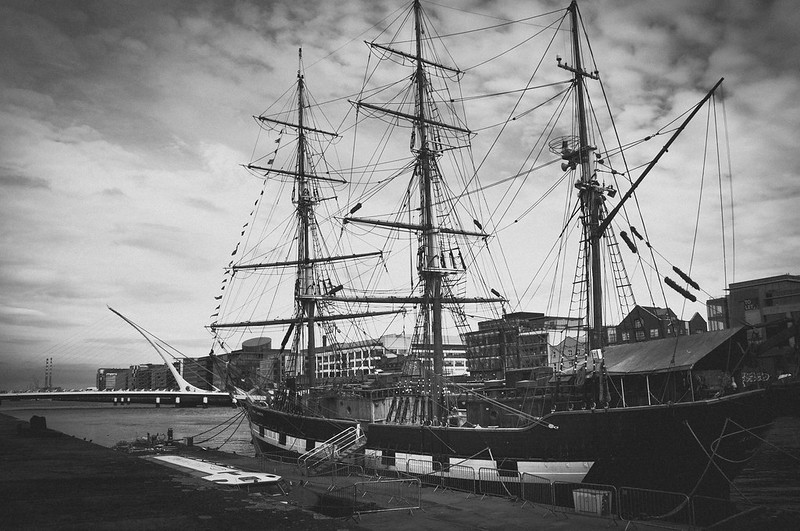
In what has already been a strange and unpredictable year, the emerging trend that has most taken me by surprise is the sudden surge in the popularity of sea shanties.
For reasons this auld fella may never understand, there’s been a resurgence of these nautical working songs.
How did this resurgence begin? Climb aboard and we’ll go on a quick adventure…
The Wellerman
It all started when a young Scottish man’s rendition of the 19th century whaling song, Soon May the Wellerman Come – or The Wellerman as it’s become more popularly known – caught the attention of, well, everyone.
The Wellerman became a global sensation almost overnight and has even led to a record deal for the young folk singer, Nathan Evans:
The sea shanty craze may be short-lived or maybe it’s here to stay. Who knows?
Either way, I’m hopeful that it will lead a brand new audience on a musical journey of discovery and exploration that introduces them to the exciting world of Irish folk music.
Of course, folk music enthusiasts the world over already know the appeal of this genre. It’s a staple of many folk music traditions.
Such is its popularity in traditional Irish music that a Sea Shanty Festival takes place in Rosses Point, Co. Sligo each year:
But what is it that makes these folk songs so popular? The catchy melodies? The collaborative storytelling? The endless potential for close harmony?
They’re great singalong songs if you’re not into solo singing. Like all good folk music, the songs tell a good story and that’s really why they should be preserved, because they talk about the life of sailors at sea in the 19th century.
– Willie Murphy
Whatever the reason, it’s a welcome opportunity to re-explore some of my favourite folk songs and to introduce you to some of the best Irish sea shanties.
What is a Sea Shanty?
First things first. A sea shanty is not just any old nautically themed song. The term most commonly refers to 19th century working songs sung on board the ships of the transatlantic merchant navy.
These songs served a purpose – maintaining morale and synchronising the onboard labour. The coordinated shanties, with their call and response style, created a unified rhythm for the small crews to perform tasks.
Different songs were used to coordinate different tasks:
- The capstan shanty was used to crank the windlass – lower or raise the anchor – though it was also sung while doing other jobs.
- The halyard shanty was used for hoisting sails, with the song’s form varying according to which sail was being hoisted.
For pumping, any old sea song or popular song would do, as long as it had a rousing chorus that everyone could sing along with. This is where much of the confusion relating to classifying songs as shanties originates.
Many of these sea shanties served multiple purposes, with the structure of the song changing to suit the needs of the crew at the time.
The shantyman, or foreman, was responsible for leading the sing and coordinating his crew. It was up to him to set the pace. Apparently a good singing voice could earn you a few extra bob on the job!
Irish Sea Shanties
Sea shanties are a hybridised form of music. Ships, as you can imagine, were cultural melting pots. There is no denying however, a distinct Irish influence on the genre.
What Shall We Do With The Drunken Sailor for example – possibly the best known sea shanty in the world – shares its melody with the Irish folk song Óró Sé Do Bheatha ‘Bhaile.
How did this Irish influence emerge?
One of the most popular trade routes of the 19th century was Liverpool to New York – two cities famous for their large Irish immigrant communities.
It’s hardly surprising that a shipping route between two cities with such large Irish populations would be dominated by Irish crew members:
Many shanties had Irish tunes – dance, folk, and march – and not only were the words and phrases of many of the shanties of Irish origin but in some cases it was customary for the shantyman to sing the shanties with an imitative Irish brogue.
The Packet Rats of the Western Ocean Packets were almost one hundred per cent Irish… and as these seamen were responsible for many of our finest shanties it was only natural for them to choose tunes and words from Irish sources when they made up these songs.
– Stan Hugill
And as we Irish are prone to doing, everywhere we went, we brought our musical tradition with us. The high seas were no exception!
Leave Her Johnny Leave Her
Leave Her Johnny Leave Her is one of the best known sea shanties and one that is frequently sung in traditional Irish music circles.
It originally served as a capstan, halyard and pump shanty, depending on which format it was sung in.
It was most often sung at the end of the voyage however, during the last round of pumping, as an opportunity for the crew to vent any frustrations accumulated while at sea:
Leave her, Johnny, leave her!
Oh, leave her, Johnny, leave her!
For the voyage is done and the winds don’t blow,
And it’s time for us to leave her.
The ‘her’ in question was the ship, but there’s no denying it was a good idea to leave one’s grievances behind too before disembarking, tied up in the port with the ship.
This shanty is thought to have originated around the time of the Great Irish Famine.
One of my favourite versions is sung here by the iconic duo that is Tommy Makem and Liam Clancy. Though, it is perhaps a bit more sentimental than the original would have been:
Clear the Track, Let the Bulgine Run
Clear the Track, also known as Eliza Lee, began its life, believe it or not, as an Irish love song. This popular sea shanty shares the melody of the famous traditional Irish folk song, Siúl a Ghrá.
It travelled to America where it was sung by workers on the railroad network. Hence the reference to the Bulgine which was a slang term for a railway engine:
Hey rig a jig in a low back car,
A he, a ho, are you most done?
Eliza Lee all on my knee,
Clear away the track and let the bulgine run.
From there, it found its way back to the ports where it was picked up by ship workers and sung as a capstan shanty.
By this stage it had picked up a number of musical influences along the way however, most notably an African American influence from its time on the railways.
So while its roots are firmly Irish, the song itself should today be considered transatlantic:
We’re All Bound to Go
We’re All Bound to Go – also known as The Irish Emigrant Song or Heave Away My Johnny – is a song that served as an outward-bound brake-windlass shanty.
Sung to melody of a jig, the original version of the shanty, collected by Stan Hugill, tells the tale of a sailor’s misadventure on board a ship.
As with most shanties and folk songs however, several versions exist.
Some focus on the tough life of the crew member on board the packet ships, others, like the version below, focus less on the details of the trip and more on the act of leaving itself:
Fall Down Billy O’Shea
Fall Down Billy O’Shea is one of my favourite sea shanties of all time. I have a slight confession to make however. It’s not technically an ‘authentic’ sea shanty…
While it’s frequently used as an example of an Irish sea shanty, this iconic folk song was actually written in the 1960s by Dublin musician Iain McCarthy.
Written in the style of a sea shanty, it tells the tale of a sorry group of men who got drunk in Dublin city and woke up to find themselves bound for America as crew members:
Fall down, fall down, fall down me
Billy We’re bound away for Americay,
Fall down Billy O’Shea
Here it is, performed back in 2014 (before it was cool) by the brilliant Dublin folk group, Lankum:
To be fair, it doesn’t require a great stretch of the imagination to imagine this being sung by a hardworking crew onboard a ship bound for America.
Sea Shanty Performance
The modern style of sea shanty performance that has emerged in recent years, most notably groups singing together in close harmony, isn’t really an accurate reflection of how these songs would have originally been sung.
There’s no denying that sea shanties lend themselves well to this particular style of musical performance however! And it’s definitely far more pleasant to listen to than some collective out of tune grunting aboard a ship.
If you’re lacking someone to sing harmony with however, there’s always instrumental accompaniment.
While the unique modal sound of the Irish bouzouki lends itself well to accompanying these songs, for a more authentic performance you could consider opting for the fiddle or concertina.
The English concertina in particular is strongly associated with the sea shanty tradition and offers the ability to play either chords or melody.
So if, like the rest of the world, sea shanties have stolen your heart, why not fully embrace the trend and help to keep this fine folk tradition alive.
[Featured Image: Famine Ship by Michelle O’Riordan, CC BY 2.0]





Share your thoughts
Thanks a lot I like this a lot!!
Thanks Nan! I enjoyed researching this.
Those many folks in Ireland and England who have been singing shanties since the late sixties, whilst celebrating the success of Wellerman, would not consider this to be how it all started - case in point, Fall Down Billy O'Shea was written in 1965
You're absolutely right, that's what I was hoping to highlight here. My reference to "how it all began" is in relation to this resurgence or viral trend. Sure sea Shanties have been popular longer than I've been around myself, and long may it continue.
I am planning a celebration with some Irish Sea Shanties in Örebro, Sweden where I live, so I’m really happy that I found your blog!
Wonderful news Olle! Best of luck with the celebration. I'd love to hear more about it.
Hi, thanks for an interesting read. Any recommendations of good irish sea shanty cds or playlists?
I think you are very mistaken here. Sea shanties are British and they are much older than the 19th Century. The most popular ones are Navy songs from the Napoleonic era although they go way back to the Vikings. I had never heard of an Irish Sea shanty beforei. ts great that Irish musicians have been enjoying and performing British trad music in modern times.
Many crew members in British Royal Navy ships from the Napoleonic era (and before) were in fact Irish. This is well documented in historical archives. So it is hardly surprising that these crews would be singing or adapting songs they knew well ie Irish folk songs.
Lots of links there, for sure!
Just found your stories and recordings of sea shantys . I am a member of The Molgoggers a group from Cobh Co Cork we started out in 2013 and still going, been to Poland 9 years going to Falmouth 4 years to Portaferry Ballycastle Galway and this was our 4th year at Electric Picnic and various venues in Ireland. Great to sea the shantys still going,
That's class, George! We do love a good sea shanty. All the best for your group's next shows.
A lovely read, thank you
What a great article and education love this appreciate you sending this.
Thank you for this!
Made me chuckle when I saw your blog. I've been part of a Sea Music band, The Dogwatch Nautical Band since the late 1970s here in a San Francisco Bay area. For the last 25 years Shay Black has been a member, occasionally we get to sing with Michael as well. Back in 1981 National Park Ranger Dave Nettell started a monthly Chantey sing on board the 1891 three masted schooner C.A.Thayer, the sings continue to this day. The playwright Eugene O'Neil was part of a group who met in a Greenwich Village book shop to sing sea songs in the early 1920s. I have a 1924 copy of a book that came out of these sessions. A baritone from the UK traveled around North America in the 1920s performing Chanties including at a Vancouver Canada Sea Music Festival in 1926. People were already preserving these songs. as the last windjammer sailors were passing on the songs to a young Stan Hugill. Heres John Goss doing Sailor Likes his Bottle and Eliza Lee recorded in the 1930s, https://www.youtube.com/watch?v=StrYc3yhH4c. Here's Shay leading 4/6ths of our group in The Old Moke at The San Francisco Free Folk Festival in 2013. https://www.youtube.com/watch?v=RRHhRmJGVXU. And lastly, I love my Phoenix Anglo concertina I purchased from you as a retirement gift to myself 3 years ago. ;) All the best!
Probably Sea Shanties predate most rhythmic forms. All work has some roots in some sort of singing , chanting, drumming, etc. All countries probably had early shipping with some form of water vessels and probably all have a heritage in Sea Shanties. Many of the ones we study came about in that glorious period of "Packet Ships" to and from the old world to the new world. Yes, Ireland having a huge part of that market, many of our Sea Shanties either originated there or were picked up in other parts of the world and taken back to Ireland and vice versa. The Gulf of Mexico had a whole culture of Sea Shanties originating out of our African American Culture with crews that reflected that culture. Really fun stuff and certainly hope that it will be preserved. Unfortunately, there is not a lot of interest in our area in the USA. I just happen to really like history!
I sing in a shanty band in Cornwall, UK and my McNeela 18" bodhran fits in beautifully. It's the perfect instrument to keep the rhythm going.
Nice write up about a topic that has so much history. I've been in a sea music/Irish band (Dogwatch Nautical Band) here in the San Francisco area since 1978. Seeing your use of the Black Family doing Eliza Lee made me smile. Shay Black has been part of our band for about 25 years. I've had the privilege of singing with Michael as well. I was fortunate to spend time playing tour guide for Stan Hugill in the early 80s when I was a ranger at the National Maritime Historic Park, a day walking music, history , visiting museums and then a bit of a pub crawl. I have a first printing of Frank Shay's Iron Men and Wooden Ships published in 1924 that came out of Chantey session he held with the playwright Eugene O'Neil in a book shop in Greenwich Village. They were celebrating and preserving the tradition of Sea Chanteys while there were still plenty of sailing ships still working. British baritone John Goss sang chanteys at the Vancouver BC Sea Music Festival in 1926! There are 78 recordings of him form the 1930s on YouTube. Our friend Dick Holdstock sang a few months ago at our local Festival of The Sea and was belting out the songs at 92 years old! We should all be so lucky. I should mention my fine McNeela Phoenix concertina has been a great addition to our bands sound, a great gift I bought myself for retirement;)
After 25+ years of solo, A Capella folk singing, with shanties and sea songs as my favourites I finally got together a group of singers to form our own shanty crew! After only 15 months of singing together, we've gone from strength to strength and look forward to another busy year in 2026! All of the shanties you've listed in this blog are already in our repertoire or on my list for inclusion! Stan Hugill's "Shanties from the Seven Seas" is my shanty bible and an invaluable source of words and music! I highly recommend it to anyone with a serious interest! Dave Bainbridge, Cumbria.